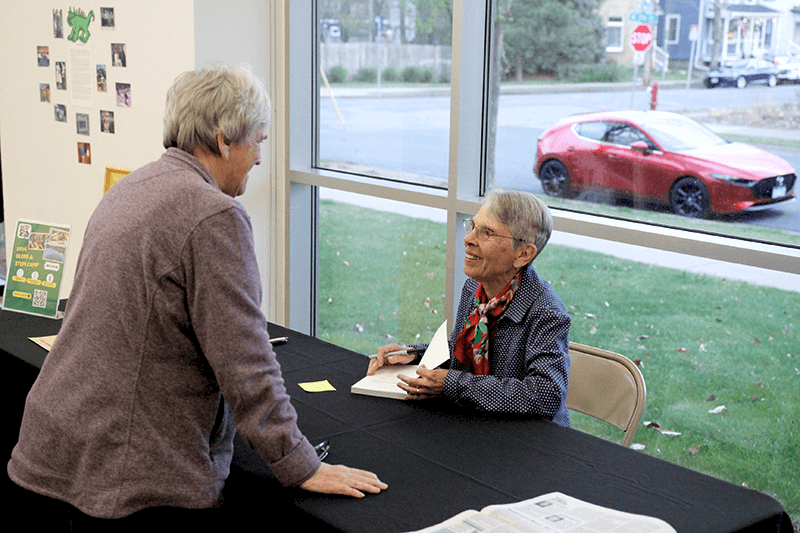Of all the things Caroline Scheaffer Arnold remembers from her youth living at the Northeast Neighborhood house, the recreation programs offered there stand out the most. Among the memories of her childhood, those of Camp Bovey shine particularly bright. The settlement house’s summer campground in northern Wisconsin occupies a joyful place in her mind as well as in several chapters of her recently published memoir, “Settlement House Girl” (featured in the April 3 edition of The Northeaster).
Camp Bovey is celebrating its 75th anniversary this year, coinciding neatly with the release of Arnold’s book in December last year. Though “Settlement House Girl” doesn’t predominantly focus on Camp Bovey, Arnold still regaled fans with tales from her time there at a book signing and celebration of the camp at East Side Neighborhood Services (ESNS) on the evening of April 18.
Most of the book is about life in Northeast in the 1950s and about growing up as a full-time resident of a settlement house (a community center serving communities of immigrant workers where the staff lives on-site). The NE Neighborhood House eventually evolved into East Side Neighborhood Services, but Camp Bovey remains relatively unchanged since it was founded by Arnold’s father, who was the settlement house director at the time, in 1959.
The camp became an important part of Arnold’s formative years, and when she got older she even became a camp counselor. Among other tales, she fondly recounted getting “kidnapped” by some of the boys under her charge one year and pretending to be their “Indian Princess” while they ran errands for her and acted as her security detail around the camp.
“Camp Bovey is embedded in all my memories of my 18 years here [in Minneapolis],” she said. “Saying goodbye the year my family decided to move to California was saying goodbye to my childhood.”
While “Settlement House Girl” is geared more towards adults, Arnold has written over 170 children’s books. She originally planned to get into children’s book illustration, but writing ended up calling to her more when she was getting into the industry. She didn’t like the limitation of only being able to print in black and white at the time, and since she always had to be coming up with stories to illustrate anyways, she ended up ultimately becoming a writer. Later in her career, she returned to painting now that printing technology lets her have a little more fun with it.
Arnold’s books are frequently about the outdoors, animals and nature, subjects she came to appreciate at Camp Bovey and that she loves to get kids interested in through her writing. Most of her books are readily available online, and “Settlement House Girl” can be found locally at Eat My Words bookstore on 13th Avenue NE.
Some of Arnold’s other books also link back to Camp Bovey. Before it was renamed to commemorate the family who donated much of the money to buy the land, the camp was originally named Camp Hodag, after a Northwoods cryptid said to have the head of a frog, horns of an ox and spines running down its dinosaur-like body. The creature was a popular tall tale amongst long-past lumber camps from around the area, and it appears in two fiction books she wrote, inspired by its connection to her own past. The visage of the Hodag lives on as a mascot for the camp as well.
ESNS isn’t done celebrating Camp Bovey’s 75th anniversary just yet. A party, dubbed Beats for Bovey, is tentatively planned for June 15, but times are to be determined. ESNS continues to raise money to pay for maintenance and renovation to the camp, as 75 years have taken their toll on some of the camp’s infrastructure. The agency also offers scholarships for families who may not be able to afford to send their children to a summer camp.
More information can be found on their website at www.esns.org/campbovey.

Caroline Scheaffer Arnold, right, signed copies of her book, “Settlement Girl” at East Side Neighborhood Services April 18. It was a kickoff of a monthslong celebration of the 75th anniversary of Camp Bovey, which was started by Arnold’s father. (Alex Schlee)